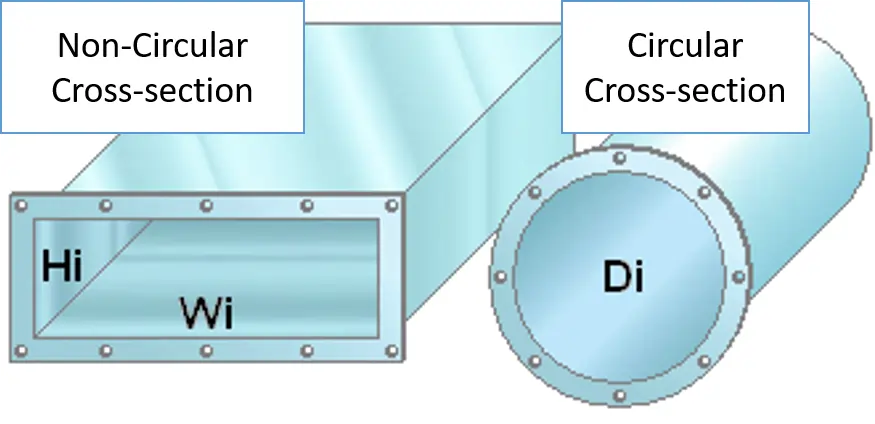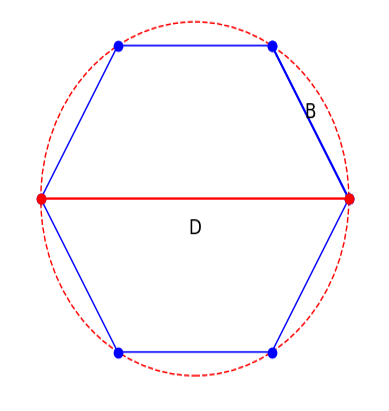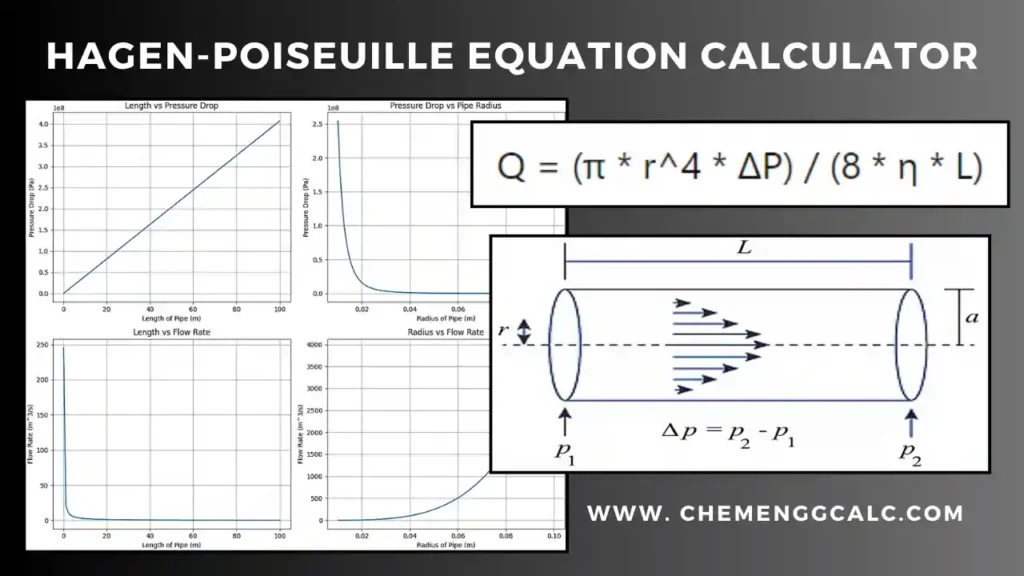Table of Contents
What is Hydraulic Diameter?
The hydraulic diameter is a parameter which is used for handling flow in non-circular tubes and channels. It’s not a physical diameter, but a calculated value that takes into account the shape of the flow channel.

The hydraulic diameter, \(D_H\), is defined as four times the cross-sectional area of the channel divided by the wetted perimeter.
\[D_H = \frac{4A}{P}\]
where:
- (A) is the cross-sectional area of the flow
- (P) is the wetted perimeter of the cross-section
Note: Wetted Perimeter includes all surfaces acted upon by shear stress from the fluid.
For a circular pipe, the hydraulic diameter is simply the diameter of the pipe. For non-circular cross-section channels, such as a rectangular duct, the \(D_H\) is calculated using the above formula.
Related: Newton’s Law of Viscosity Calculator – Dynamic Viscosity
Related: Other Fluid Mechanics Calculators
Hydraulic Diameter Calculator for Non-Circular Cross-section
This calculator computes the \(D_H\) of a channel or pipe. Users input the height of the duct in meters (h) and width of the duct in meters (W), and the calculator uses the formula \(D_h = \frac{4 \times WH}{2(W+H)}\). This value is useful in fluid dynamics calculations, particularly in determining flow characteristics in non-circular conduits flow situations.
Related: Hagen-Poiseuille Equation Calculator / Poiseuille’s Law Solver
Hydraulic Diameter Calculator for Circular Cross-section
This calculator computes the \(D_H\) of a channel or pipe given its cross-sectional area and wetted perimeter for a circular cross-section. Users input the area (A) in square meters and the wetted perimeter (P) in meters, and the calculator uses the formula \(D_h = \frac{4A}{P}\). This value is useful in fluid dynamics calculations, particularly in determining flow characteristics in circular conduits flow situations.
List of Hydraulic Diameters
| Geometry | Hydraulic Diameter | Comment |
|---|---|---|
| Circular tube | \[ D_H = \frac{4 \cdot \frac{\pi D^2}{4}}{\pi D} = D \] | For a circular tube, the hydraulic diameter is equal to the diameter of the tube. |
| Annulus | \[ D_H = \frac{4 \cdot \frac{\pi (D_{\text{out}}^2 – D_{\text{in}}^2)}{4}}{\pi (D_{\text{out}} + D_{\text{in}})}\] \[ D_H = D_{\text{out}} – D_{\text{in}} \] | For an annulus, \(D_{in}\) \(D_{out}\) represents the inner and outer diameter of the annulus. |
| Square duct | \[ D_H = \frac{4a^2}{4a} = a \] | Here, \( a \) represents the length of a side |
| Rectangular duct (fully filled) | \[ D_H = \frac{4ab}{2(a+b)} \] \[D_H = \frac{2ab}{a+b} \] | For special case of a very wide duct, i.e., a slot of width \( b \), where \( b \gg a \), then \( D_H = 2a \). |
| Partially filled rectangular duct (open from top) | \[ D_H = \frac{4ab}{2a + b} \] | For special case of a very wide duct, i.e., a slot of width \( b \), where \( b \gg a \), and \( a \) is the water depth, then \( D_H = 4a \). |
Hydraulic Diameter for Regular Polygon
For a fully filled duct or pipe whose cross-section is a regular polygon, the \(D_H\) is equivalent to the diameter \( D \) of a circle inscribed within the wetted perimeter.
This can be seen as follows: The \( N \)-sided regular polygon is a union of \( N \) triangles,
Height of each triangle is \( \frac{D}{2} \)
Base of each triangle, \( B = D \tan \left( \frac{\pi}{N} \right) \)
Each such triangle contributes \( \frac{BD}{4} \) to the total area and \( B \) to the total perimeter, giving
\[ D_H = 4 \frac{N \left( \frac{BD}{4} \right)}{N B} = D \]

Python Code for Hydraulic Diameter
This Python code helps user to calculate hydraulic diameter for different cross-sections, specifically circular and rectangular. For circular cross-sections, the code calculates the \(D_h\) for different diameters. For rectangular cross-sections, it calculates the hydraulic diameter for different widths and heights.
Note: This Python code solves the specified problem. Users can copy the code and run it in a suitable Python environment. By adjusting the input parameters, users can observe how the output changes accordingly.
import numpy as np
import matplotlib.pyplot as plt
# Function to calculate hydraulic_diameter
def hydraulic_diameter(area, perimeter):
return 4 * area / perimeter
# Circular cross-section
diameter = np.linspace(0.1, 10, 100) # Diameter in meters
circular_area = np.pi * (diameter / 2)**2
circular_perimeter = np.pi * diameter
circular_dh = hydraulic_diameter(circular_area, circular_perimeter)
# Plotting for circular cross-section
plt.figure(figsize=(10, 6))
plt.plot(diameter, circular_dh, label='Circular Cross-section')
plt.xlabel('Diameter (m)')
plt.ylabel('Hydraulic Diameter (m)')
plt.title('Hydraulic_Diameter for Circular Cross-section')
plt.legend()
plt.grid(True)
plt.show()
# Rectangular cross-section for different heights
width = np.linspace(0.1, 10, 100) # Width in meters
heights = [1, 2, 3] # Different heights in meters
plt.figure(figsize=(10, 6))
for height in heights:
rectangular_area = width * height
rectangular_perimeter = 2 * (width + height)
rectangular_dh = hydraulic_diameter(rectangular_area, rectangular_perimeter)
plt.plot(width, rectangular_dh, label=f'Rectangular Cross-section, Height={height}m')
plt.xlabel('Width (m)')
plt.ylabel('Hydraulic_Diameter (m)')
plt.title('Hydraulic_Diameter for Rectangular Cross-sections with Different Heights')
plt.legend()
plt.grid(True)
plt.show()Output:


Resources
- “Fluid Mechanics” by Frank M. White
- “Introduction to Fluid Mechanics” by Robert W. Fox, Alan T. McDonald, and Philip J. Pritchard
- “Principles of Heat and Mass Transfer” by Frank P. Incropera and David P. DeWitt
- Python.org – The official Python website offers tutorials, documentation, and resources for learning Python.
Disclaimer: The Solver provided here is for educational purposes. While efforts ensure accuracy, results may not always reflect real-world scenarios. Verify results with other sources and consult professionals for critical applications. Contact us for any suggestions or corrections.






